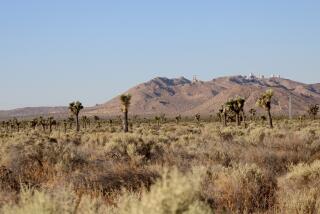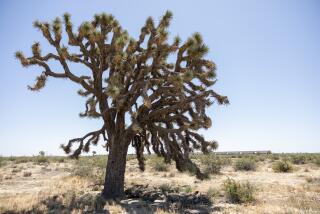U.S. Paves Way for Building of Telescopes : Environment: Study of impact on endangered red squirrel is held not necessary for Arizona project. Conservationists will fight the ruling.
- Share via
In a move sure to spark a challenge from environmentalists, the U.S. Forest Service on Thursday cleared the way for the construction of three telescopes on an Arizona mountaintop occupied by an endangered red squirrel.
After a lengthy review, the Justice Department told Forest Service officials that they could issue a permit for the astronomical observatory without requiring further study of its threat to the imperiled Mt. Graham red squirrel.
George H. Leonard, associate chief of the Forest Service, pledged that his agency “will carefully monitor and report on the squirrel population” during the construction of the telescopes.
Moreover, he said that the project will be shut down and re-evaluated if it results in harm to more than six squirrels in a single year.
The University of Arizona, which has sought to build its $200-million Mt. Graham International Observatory since 1984, heralded the decision and said work to clear the site for the first telescope could begin next week.
“The astronomers are anxious to get started,” university spokesman Steve Emerine said. “They’ve been waiting a long, long time.”
Reaction to the news from conservationists and other foes, however, suggested that they may have to wait still longer.
“We’ll be in court in the morning,” warned Robin Silver, a Phoenix Audubon Society leader.
“We consider this action a breach of public trust,” Duane L. Shroufe, director of the Arizona Game and Fish Department, added in a statement. “How scientists who purport to be reaching for the stars can have so little foresight about what is beneath their feet is beyond belief.”
The Mt. Graham red squirrel, once abundant in the forests that cap the 10,700-foot mountain south of Tucson, has declined precipitately in recent years, mostly because of piecemeal losses of habitat.
The shy half-pound animal was added to the nation’s list of endangered species in 1987. The species, found only on Mt. Graham, now numbers as few as 132.
Despite the listing, the university--aided by such prestigious partners as the Vatican and the Smithsonian Institution--pressed forward with its project, which includes one instrument billed as the world’s most powerful land-based telescope.
Initially, U.S. Fish and Wildlife Service biologists concluded that squirrels and astronomy could coexist on Mt. Graham. But later, in depositions prepared as part of a lawsuit seeking to block the telescopes, those same biologists disclosed that they had been ordered by superiors to prepare documents that supported the project.
That disclosure sparked a flurry of events ending with the formation of a blue-ribbon panel of federal scientists to study the issue. Their report, released earlier this month, concluded that a fresh assessment of the observatory’s threat to the squirrel was warranted.
But the Justice Department disagreed. A statement released by the Forest Service said Administration attorneys believe a 1988 law that exempted the telescopes from certain environmental reviews made additional study of the project’s impacts unnecessary.
The tug of war over Mt. Graham represents one of the nastiest environmental battles in Arizona history. The squirrel became a national issue in May after Interior Secretary Manuel Lujan Jr., in a comment that touched off a storm of protest, said: “Nobody’s told me the difference between a red squirrel, a black one or a brown one. Do we have to save every subspecies?”
More to Read
Sign up for Essential California
The most important California stories and recommendations in your inbox every morning.
You may occasionally receive promotional content from the Los Angeles Times.













